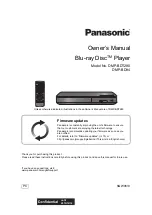
C O M M O N C O N N E C T I O N M E T H O D S
18
Connecting to an A/V Receiver via HDMI
If you have an HDMI-capable receiver that can support HDMI audio, you can simply run an HDMI
cable from the player to your receiver and enable HDMI audio on the receiver (see your receiver’s
owner’s manual for more information). The receiver usually has an HDMI output that you can
connect to your TV to pass the video signal.
The HDMI output terminal on the rear panel of the BDT-101CI can be connected to your receiver.
NOTE
HDMI (High-Definition Multimedia Interface) is a single cable that can transport both audio and
video from your player to your display. Be aware, however, that HDMI is an evolving standard, and
there may be compatibility issues. A receiver that supports audio input over HDMI is required.
Some receivers offer HDMI ports solely for video switching. If your receiver does not have audio
input capability, please read the following sections regarding other connection methods.
In order to play multi-channel audio for all formats, the receiver must support HDMI v1.1 or later.
For Blu-ray Discs, a receiver that supports HDMI v1.4 with decoding capability for Dolby TrueHD
and DTS-HD Master Audio is preferred. Please check the specifications of your receiver to ensure
that it meets these requirements.
















































